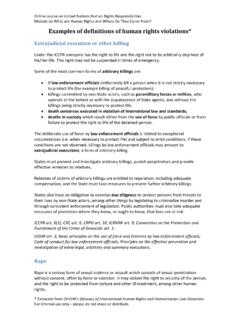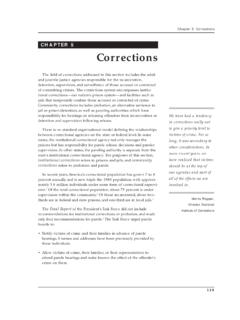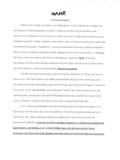Transcription of The NIJ Recidivism Forecasting Challenge: Contextualizing ...
1 Department of Justice Office of Justice Programs National Institute of Justice NATIONAL INSTITUTE OF JUSTICE. THE NIJ Recidivism . Forecasting CHALLENGE: Contextualizing THE RESULTS. Veronica White D. Michael Applegarth Joel Hunt Caleb Hudgins February 2022. Department of Justice Office of Justice Programs 810 Seventh St. Washington, DC 20531. Jennifer Scherer, Acting Director, National Institute of Justice This and other publications and products of the National Institute of Justice can be found at: National Institute of Justice Strengthen Science Advance Justice Office of Justice Programs Building Solutions Supporting Communities Advancing Justice The National Institute of Justice is the research, development, and evaluation agency of the Department of Justice. NIJ's mission is to advance scientific research, development, and evaluation to enhance the administration of justice and public safety. The National Institute of Justice is a component of the Office of Justice Programs, which also includes the Bureau of Justice Assistance; the Bureau of Justice Statistics; the Office for Victims of Crime; the Office of Juvenile Justice and Delinquency Prevention; and the Office of Sex Offender Sentencing, Monitoring, Apprehending, Registering, and Tracking.
2 Opinions or conclusions expressed in this paper are those of the authors and do not necessarily reflect the official position or policies of the Department of Justice. National Institute of Justice | Contextualizing the Fiscal Year 2021 NIJ Recidivism Forecasting Challenge Results Abstract The National Institute of Justice (NIJ) recently hosted the Fiscal Year 2021 Recidivism Forecasting Challenge. The primary aim of this research competition was to increase public safety and the fair administration of justice by improving the ability to forecast and understand the variables that impact the likelihood that an individual under parole supervision will recidivate. Entrants were provided with two datasets. The first was a training dataset of over 18,000 individuals released from prison to parole supervision in the state of Georgia during the period of January 1, 2013, through December 31, 2015. These data contained information about individuals' demographic characteristics, supervision case information, prison case information, prior criminal and community supervision history in the state of Georgia, activities for current supervision, and whether they recidivated in any of the three years after they began supervision.
3 The second was a test dataset (n = 7,807) used to develop models for Forecasting the probability that an individual on parole will recidivate within their first, second, or third year on parole. For each of the Challenge's three submission periods, models were scored by two indices: (1) a Brier score, which is a measure of accuracy, and (2) fairness and accuracy via a difference in the false positive rate between Black and white racial groups in conjunction with the Brier score. Prizes were awarded to the entries that had the lowest error in the forecasts for males and females, and the average of these two scores. Additionally, prizes were awarded to the entries that had the highest fairness and accuracy scores after any assessed fairness penalties. The NIJ Recidivism Forecasting Challenge: Contextualizing the Results i National Institute of Justice | In order to put these results into context, this paper compares the winning results to a variety of naive models, such as predicting Recidivism by random chance or using the average Recidivism rate by population demographic for those in the sample.
4 Naive demographic models outperformed the chance model, and submitted forecasts outperformed the best naive demographic models. This suggests that more advanced algorithms have improved the capability of determining which variables accurately forecast Recidivism . Improved algorithms could assist community corrections agencies in identifying and prioritizing the needs of those on parole and promoting more successful reintegration into society. Future papers will consider alternative metrics for fairness and accuracy, provide a more detailed comparison of submissions, and explore practical implications for predicting Recidivism . ii The NIJ Recidivism Forecasting Challenge: Contextualizing the Results National Institute of Justice | Introduction The National Institute of Justice (NIJ) recently hosted the Fiscal Year 2021 Recidivism Forecasting Challenge. The primary aim of the Challenge was to increase public safety and the fair administration of justice by understanding the factors that drive Recidivism .
5 To do so, Challenge entrants were given a dataset that allowed them to explore gender, racial, and age differences for individuals on parole, in addition to a host of other variables described below. The Challenge was designed to improve the accuracy and fairness of forecasts by identifying key variables, accounting for gender-specific needs, and adjusting for potential racial bias in predicting Recidivism . NIJ's aim was to increase public safety and the fair administration of justice by improving the ability to forecast and understand the variables that impact the likelihood that an individual under parole supervision will recidivate. The Challenge encouraged data scientists from all fields to build upon the current knowledge base for Forecasting Recidivism while also infusing innovative methods and new perspectives. Here, NIJ provides a brief overview of the Challenge and the metrics used to judge the entries, and contextualizes how the winners' forecasts performed compared to several naive models in terms of accuracy and fairness.
6 A detailed description of the Challenge is available on the NIJ 1. Recidivism Forecasting Challenge, National Institute of Justice, The NIJ Recidivism Forecasting Challenge: Contextualizing the Results 1. National Institute of Justice | Challenge Background The Challenge used data from the state of Georgia that contained records for over 25,000 persons released from prison to parole supervision during the period of January 1, 2013, through December 31, The dataset included the following variable categories: supervision case information ( , gender, race, and age group), prison case information ( , education level upon entry, crime of conviction), prior Georgia criminal history ( , number of prior arrests, type of arrests), prior Georgia community supervision history ( , prior revocations), conditions of current supervision period ( , mental health or substance abuse programming), supervision activities for current supervision period ( , number of delinquency reports, total number of all program attendances), and four measures of Recidivism across three years of supervision.
7 Recidivism was defined as an arrest for a new felony or misdemeanor charge once the supervision period Not all individuals in the dataset were under supervision for the entire three years of the dataset; however, if individuals were arrested for new felony or misdemeanor crimes within three years of the start of their parole, they were still classified as recidivating. Geographic information was also provided pertaining to where individuals were initially released on parole. In order to minimize the risk of disclosing personally identifiable information, a combined public use microdata area4 was provided for each individual. Merging additional outside data sources into the Challenge's dataset was encouraged, allowing each submission to incorporate unique variables. 2. The Challenge data only contain individuals with the racial categories of Black and white. In the original dataset, fewer than 500 individuals were identified as Hispanic, and fewer than 100 individuals each were identified as Asian, Native American, other, or unknown.
8 All five of these categories were dropped from the sample to prevent inadvertent disclosure of personal identifying information. It should also be noted that the state identified individuals' race, ethnicity, and gender, meaning individuals may not have self- identified with the categories in which they were ultimately classified. Among other things, this potentially impacted the number of individuals identified as Hispanic, as they may have been labeled as white. NIJ. maintained the naming conventions for the variables provided by the state of Georgia ( , gender, race). For more information on how the Challenge dataset was prepared, visit Recidivism - Forecasting -challenge#appendi ces. 3. For a complete description of the variables contained in the dataset, see the Challenge codebook at https://nij. # Recidivism - Forecasting -challenge-databa se-fields-defined. 4. A public use microdata area (PUMA) is based on aggregations of counties and census tracts. Each PUMA must have a population of 100,000 or more throughout the census decade, and the building blocks for the PUMA.
9 Must be continuous, unless the area is an island. For this Challenge, PUMA blocks were collapsed to reduce risk of identification. For more information on how this was done, visit Forecasting -challenge#j55a9e. For more information on how PUMAs are developed and used, visit https://www. The NIJ Recidivism Forecasting Challenge: Contextualizing the Results 3. National Institute of Justice | Descriptive Statistics of Provided Datasets For the Challenge, the dataset was split into two subsets: training and test data. NIJ used a random 70/30 split, placing 70% of the total dataset in the training set and 30% in the test set. NIJ ensured that the random split produced equal distributions on key variables ( , Recidivism , gender, age, race, education, prerelease risk scores). NIJ also conducted a disclosure risk analysis to ensure appropriate steps were taken to reduce the risk of deductive disclosure of individuals' Exhibits 1 and 2 provide the descriptive statistics for the training and test datasets.
10 The exhibits are presented by gender to support one of the Challenge's aims of accounting for gender-specific needs. The demographic percentages for years 2 and 3 of the training datasets exclude individuals who had recidivated in the prior year. Exhibit 1. Challenge Datasets Descriptive Statistics for Females Year 1 Year 2 Year 3. Training Test Training Test Training Test Total N 2,217 950 1,760 742 1,396 519. Variable % % % % % %. (Recid. %)+ (Recid. %) (Recid. %) (Recid. %) (Recid. %) (Recid. %). Recidivism Overall (NA) (NA) (NA) (NA) (NA) (NA). Race Black ( ) ( ) ( ) ( ) ( ) ( ). White ( ) ( ) ( ) ( ) ( ) ( ). Age 18-22 ( ) ( ) ( ) ( ) ( ) ( ). 23-27 ( ) ( ) ( ) ( ) ( ) ( ). 28-32 ( ) ( ) ( ) ( ) ( ) ( ). 33-37 ( ) ( ) ( ) ( ) ( ) ( ). 38-42 ( ) ( ) ( ) ( ) ( ) ( ). 43-47 ( ) ( ) ( ) ( ) ( ) ( ). 48+ ( ) ( ) ( ) ( ) ( ) ( ). + Recid. % indicates the percentage of individuals who recidivated by the end of the respective calendar year. Note: Under each demographic category, the accompanying Recidivism percentage indicates the percentage of this category that recidivated by the end of that year.














